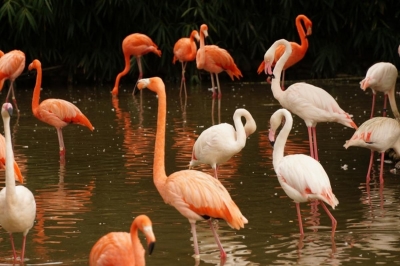
For them, camouflage seems like a good idea but instead, flamingos advertise their drumsticks with neon — literally. Some are so bright, they make your eyes hurt.
The fact that they are a little too visible is not a genetic mistake. The iconic plumage is not present at birth, nor in the first few months. By nature, flamingos are greyish-white and gradually turn pink because of what they eat. Certain crustaceans and algae contain a reddish-orange pigment called beta carotene. That’s right, the same stuff you find in carrots. Should a flamingo avoid these dyed foods, its pink would fade and eventually the bird turns white again.
Few people spare a thought about where flamingos come from. How old are they? When was the first fossilized flamingo found? Way back in the Miocene era, a lake existed in modern-day Spain. The lake dried up and left behind limestone and fossils. Incredibly, one ancient discovery was a preserved nesting site. It contained five eggs laid around 18 million years ago and presented the first traces of the flamingo.
However, the prehistoric flamingo was a little different. The adult responsible for the clutch was never found but the way it constructed the nest was unlike today’s birds. Modern flamingos build mud towers for a single egg. The fossil nest, with its five eggs, was woven from sticks and leaves. The ancient eggs shared remarkable similarities to modern-day flamingos, but since the nest compared better to grebes, a living relative of flamingos, it could’ve belonged to a mutual ancestor.
Credit : Owlcation
Picture Credit : Google




